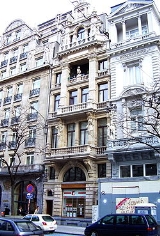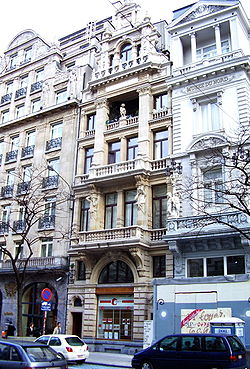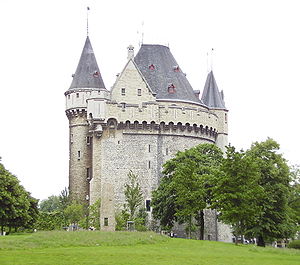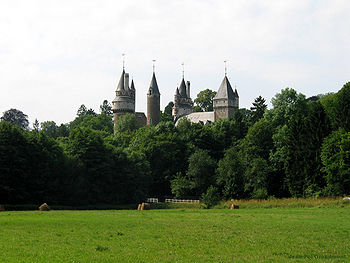
Hendrik Beyaert
Encyclopedia

French language
French is a Romance language spoken as a first language in France, the Romandy region in Switzerland, Wallonia and Brussels in Belgium, Monaco, the regions of Quebec and Acadia in Canada, and by various communities elsewhere. Second-language speakers of French are distributed throughout many parts...
) was a Belgian architect.
He was born in Kortrijk
Kortrijk
Kortrijk ; , ; ) is a Belgian city and municipality located in the Flemish province West Flanders...
, Belgium
Belgium
Belgium , officially the Kingdom of Belgium, is a federal state in Western Europe. It is a founding member of the European Union and hosts the EU's headquarters, and those of several other major international organisations such as NATO.Belgium is also a member of, or affiliated to, many...
on 29 July 1823 and died in Brussels 22 January 1894. He is considered one of the most important Belgian architects of the 19th-century.
Career
Hendrik Beyaert was of very humble descent. For this reason he had to earn his living from a very young age onwards. Initially he and his family couldn't afford to finance higher studies. At age 19, Hendrik Beyaert worked as a bank employee at the National Bank of BelgiumNational Bank of Belgium
The National Bank of Belgium has been the central bank of Belgium since 1850...
's office in Kortrijk. He found his profession not very indulging and decided to quit the bank. As he had always been fascinated by architecture he found a post as an apprentice stonemason on the building site of the new railway station of Tournai
Tournai
Tournai is a Walloon city and municipality of Belgium located 85 kilometres southwest of Brussels, on the river Scheldt, in the province of Hainaut....
, a building that would be replaced decades later by a design of Hendrik Beyeart himself.
In 1842 the young man went to Brussels
Brussels
Brussels , officially the Brussels Region or Brussels-Capital Region , is the capital of Belgium and the de facto capital of the European Union...
where he kept a small bookshop to earn his living and where he enrolled at the Académie to attend the architecture courses. In the following year he met the architect Félix Janlet who believed in the young Beyaert's exceptional qualities and who offered him a job in his office. Due to this job and to a small scholarship granted to him by his native city Kortrijk
Kortrijk
Kortrijk ; , ; ) is a Belgian city and municipality located in the Flemish province West Flanders...
, Beyaert could finish his architectures studies at the Académie Royale des Beaux-Arts
Académie Royale des Beaux-Arts
The Académie Royale des Beaux-Arts in Brussels is an art school, founded in 1711.The faculty and alumni of ARBA include some of the most famous names in Belgian painting, sculpture, and architecture: James Ensor, Rene Magritte, and Paul Delvaux...
which he completed in 1846. At the Académie he studied with Tilman-François Suys
Tilman-François Suys
Tilman-François Suys or Tieleman Frans Suys , was a Belgian architect who also worked in the Netherlands....
by whom he was largely influenced during the first years of his career as an independent architect. Beyaert gradually moved away from the neo-classical style if his master and began to experiment with a neo-Louis XVI style in the mansions he built along the Brussels Avenue des Arts and Chaussée de Charleroi.
His first public commission was the head-office of his former employer, the "Banque Nationale de Belgique". This cooperation with the architect Wynand Janssens resulted in a lavish neo-baroque building heavily influenced by the new style propagated in Paris, known as Second Empire. The critical success that it enjoyed, together with Beyaert’s connections with the powerful Liberal Party, led to many other commissions, beginning with the De Brouckère fountain (1866), now on the Square Jan Palfijn
Jan Palfijn
Jan Palfijn was a Flemish surgeon and obstetrician who was a native of Kortrijk, Flanders...
, Laeken. Other major works followed in rapid succession. In his major renovation projects of medieval buildings, such as the "Hallepoort" (or "Porte de Hal", a vestige of the medieval fortifications of Brussels) he was influenced by the French architect and theoretician Viollet-le-Duc. This realisation played an important role in Beyaert's architectural development for it made him aware of the importance and beauty of the local architectural styles from the late middle-ages and the early renaissance. Beyaert's style largely shifted to the so called "Flemish Renaissance Revival" which partly under his influence would become a very popular "National" style in the last quarter of the 19th-century. Other works included the Antwerp Office of the National Bank of Belgium building (1874–79), built on a clever triangular plan, the Tournai Railway Station
Tournai Railway Station
The railway station of Tournai, in Belgium, is situated on line 94. The first train arrived there on 24 January 1842.A first neo-classical stone building dating from the 1840s was later dismantled and replaced to serve as the railway station of the...
(1875–79, damaged in WWII), and the Kegeljan-Godin house (1878–1880) in Namur
Namur (city)
Namur is a city and municipality in Wallonia, in southern Belgium. It is both the capital of the province of Namur and of Wallonia....
. All had a similar, vaguely Flemish Renaissance or Baroque Revival flavour. In 1876 however, Beyaert publicly denied being a partisan of the nascent Flemish Renaissance Revival movement in Belgium, although the proponents of this movement had wished to align his creations to their own.
With his passion for study and novelties - Beyaert possessed an extensive library on the history of architecture and the decorative arts - his buildings became more and more charged with historical ornamentation without however lacking a clear structural basis. In an architecture contest following the covering of the Zenne, Beyaert's "Maison des Chats/Kattenhuis" took first prize. It was built along the new central boulevard in Brussels and showed clear affinities with the famous Guild Houses at the nearby Brussels Grand Place
Grand Place
The Grand Place or Grote Markt is the central square of Brussels. It is surrounded by guildhalls, the city's Town Hall, and the Breadhouse . The square is the most important tourist destination and most memorable landmark in Brussels, along with the Atomium and Manneken Pis...
. Beyaert also designed a number of country houses, including the "Romantic" Château de Faulx-les-Tombes near Namur (1872) which was highly influenced by Viollet-le-Duc's restoration of the Château de Pierrefonds
Château de Pierrefonds
The Château de Pierrefonds is a castle situated in the commune of Pierrefonds in the Oise département of France. It is on the southeast edge of the Forest of Compiègne, north of Paris, between Villers-Cotterêts and Compiègne....
, and the Neo Flemish Renaissance, Castle of Wespelaar (1881–87) in the province of Brabant. Although he had been interested in urban planning since the early 1860s, he could only realise one of his urban design projects: the Petit Sablon / Kleine Zavel Square (1880) in Brussels. It consists of a small park on a trapezium-shaped site, surrounded by a wrought-iron fence of inventive design. His final realisation, crowning an impressive architectural career, is the Ministry of Railways, Post, Telegraph and Navy in Brussels. This project shows Beyaerts ability to cope with a rich ornamentation without attacking the structural integrity of the building. While certainly revivalist in character, his strongly geometric architecture imitated only the spirit and seldom the details of historical models. His own details were highly original. They were part of an architecture of space and structure rather than of mere decorative appearance. In this respect Beyaert would become instrumental in the formation of a new generation of architects, such as Paul Hankar
Paul Hankar
Paul Hankar was a Belgian architect and designer who, along with Victor Horta and Henry Van de Velde, is considered one of the principal architects to work in the Art Nouveau style in Brussels at the turn of the twentieth century.-Formative Studies: Hankar was born at Frameries. He began his...
and Victor Horta
Victor Horta
Victor, Baron Horta was a Belgian architect and designer. John Julius Norwich described him as "undoubtedly the key European Art Nouveau architect." Indeed, Horta is one of the most important names in Art Nouveau architecture; the construction of his Hôtel Tassel in Brussels in 1892-3 means that...
, that would play an important part in the evolution of Art Nouveau
Art Nouveau
Art Nouveau is an international philosophy and style of art, architecture and applied art—especially the decorative arts—that were most popular during 1890–1910. The name "Art Nouveau" is French for "new art"...
architecture.
List of buildings

- Mansion - Brussels, avenue des Arts, 26 (1851)
- Mansions - Brussels, chaussée de Charleroi, 5-7-9 (1858–1860)
- Castle of Faulx-les-TombesCastle of Faulx-les-TombesFaulx-les-Tombes Castle is a 19th century château in Faulx-les-Tombes in the municipality of Gesves, province of Namur, Belgium.The first castle on the site was built in the 13th century and was a dependency of the County of Namur. In about 1340 it passed into the ownership of the Marbaix family...
(Château de Faulx-les-Tombes) (1865–1868, renovations and extensions) - Salles du Concert Noble - Brussels, rue d’Arlon, 82 (1870)
- Maison des Chats / Kattenhuis - Brussels, boulevard Adolphe Max, 1 (1874)
- Castle of Wespelaer (1881–1883) (demolished)
- Maison Kegeljan-Godin, NamurNamur (city)Namur is a city and municipality in Wallonia, in southern Belgium. It is both the capital of the province of Namur and of Wallonia....
, (1880) - Castle of Bornem or "Château Marnix de Sainte-Aldegonde", BornemBornemBornem is a municipality located in the Belgian province of Antwerp. The municipality comprises the towns of Bornem proper, Hingene, Wintam, Mariekerke and Weert. On January 1, 2006 Bornem had a total population of 20,064...
(1883–1894, renovations and extensions)
2. Public and semi-public commissions:
- Head-office of the National Bank of BelgiumNational Bank of BelgiumThe National Bank of Belgium has been the central bank of Belgium since 1850...
, Head-office of the National Bank of BelgiumNational Bank of BelgiumThe National Bank of Belgium has been the central bank of Belgium since 1850...
, Rue du Bois-Sauvage/Wildewoudstraat, Brussels, (1859–1867) - Office of the National Bank of BelgiumNational Bank of BelgiumThe National Bank of Belgium has been the central bank of Belgium since 1850...
, Berlaymontlaan, today Frankrijklei, Antwerp, (1860–1878) - Restoration and conversion into a museum of the "Hallepoort" / "Porte de Hal" (a former city gate of Brussels) (1868–1871)
- School in SoigniesSoigniesSoignies is a Walloon municipality located in the Belgian province of Hainaut.The municipality is composed of the Town of Soignies together with the villages of Casteau, Chaussée-Notre-Dame-Louvignies, Horrues, Neufvilles, Naast and Thieusies...
(1876–1877) - Office building of the National Bank of BelgiumNational Bank of BelgiumThe National Bank of Belgium has been the central bank of Belgium since 1850...
, Antwerp (1875–1879) - Tournai Railway StationTournai Railway StationThe railway station of Tournai, in Belgium, is situated on line 94. The first train arrived there on 24 January 1842.A first neo-classical stone building dating from the 1840s was later dismantled and replaced to serve as the railway station of the...
(Gare et entrepôt des douanes) - TournaiTournaiTournai is a Walloon city and municipality of Belgium located 85 kilometres southwest of Brussels, on the river Scheldt, in the province of Hainaut....
(1874–1879) - Church Saint-Joseph des Tombes - Faulx-les-Tombes (1879–1882, decoration by Paul HankarPaul HankarPaul Hankar was a Belgian architect and designer who, along with Victor Horta and Henry Van de Velde, is considered one of the principal architects to work in the Art Nouveau style in Brussels at the turn of the twentieth century.-Formative Studies: Hankar was born at Frameries. He began his...
) - Square du Petit Sablon - Kleine Zavel, Brussels (1879–1899)
- Palais de la Nation/Paleis der Natie, reconstruction and renovation, rue de la Loi/wetstraat, Brussels (1883–1886)
- Church Saint-Martin, "Sint-Martinuskerk" - Everberg (1886–1894, restoration and extension ; decoration Paul HankarPaul HankarPaul Hankar was a Belgian architect and designer who, along with Victor Horta and Henry Van de Velde, is considered one of the principal architects to work in the Art Nouveau style in Brussels at the turn of the twentieth century.-Formative Studies: Hankar was born at Frameries. He began his...
and Adolphe Crespin) - Office building for the bank: Caisse Générale d’Epargne et de Retraite/Algemene spaar- en lijfrentekas - Brussels, wolvengracht/rue Fossé aux Loups (1890).
- Ministry of Railways, Post, Telegraph and Navy, Brussels, rue de Louvain/Leuvensestraat (1890–1894).
- Fountain "De Brouckère", inaugurated en 1866, Brussels, porte de Namur/Naamsepoort, in 1957 moved to Laeken, square Jean Palfijn/Jan Palfijnsquare.

Trivia
A portrait of Hendrik Beyaert was represented on the former, 100 Belgian francBelgian franc
The franc was the currency of Belgium until 2002 when the euro was introduced into circulation. It was subdivided into centimes , 100 centiem or Centime .-History:...
banknotes.
Sources
- W. Pluym a.o., The Hôtel of the governor of the National Bank of Belgium, Antwerp, 1995.
- Exposition de l’oeuvre de Henri Beyaert, exhibition catalogue, Brussels, Musées Royaux des Arts Décoratifs et Industriel, 1904.
- J. Kennes, J. Vanderperren and J. Victoir, L’Architecture éclectique d’Henri Beyaert, Brussels, 1978.
- J. Neirynck and F. Neirynck, Travaux d’architecture exécutés en Belgique par Henri Beyaert, architecte, 2 vols., Brussels, 1881–1895.
- J. Victoir and J. Vanderperren, Henri Beyaert: Du classicisme à l’art nouveau, St Martens-Latem, 1992.
- J. Victoir and J. Vanderperren, Hendrik Beyaert. Van Classicisme tot Art Nouveau, Sint-Martens-Latem, 1992.
External links
- Hendrik Beyaert on the 100 francs banknote
- The "Concert Noble" ballroom in Brussels designed by Beyaert
- Porte de Hal / Hallepoort on Wikipedia in French

